Project Report: Strategic Financial Management Analysis
VerifiedAdded on 2020/04/21
|51
|9741
|218
Project
AI Summary
This project report delves into strategic financial management, examining critical aspects such as cost accounting, financial statement analysis, and investment appraisal. The report begins by outlining the tools and techniques of cost accounting, including its concepts, features, and importance, as well as the design and system of costing. It then moves on to analyze financial performance through financial statement analysis, evaluating statements and offering recommendations. The budgetary process of an organization is also explored, including the evaluation of budgetary targets and the development of a master budget. Further, the report discusses long-term and short-term funding sources, investment appraisal methods, and strategic investment decisions. The analysis incorporates financial ratios and comparative studies of companies like Ford Motors to assess performance and make recommendations for improvement. The report concludes with a detailed examination of the strategic investment decisions and the importance of financial information in shaping future strategies.
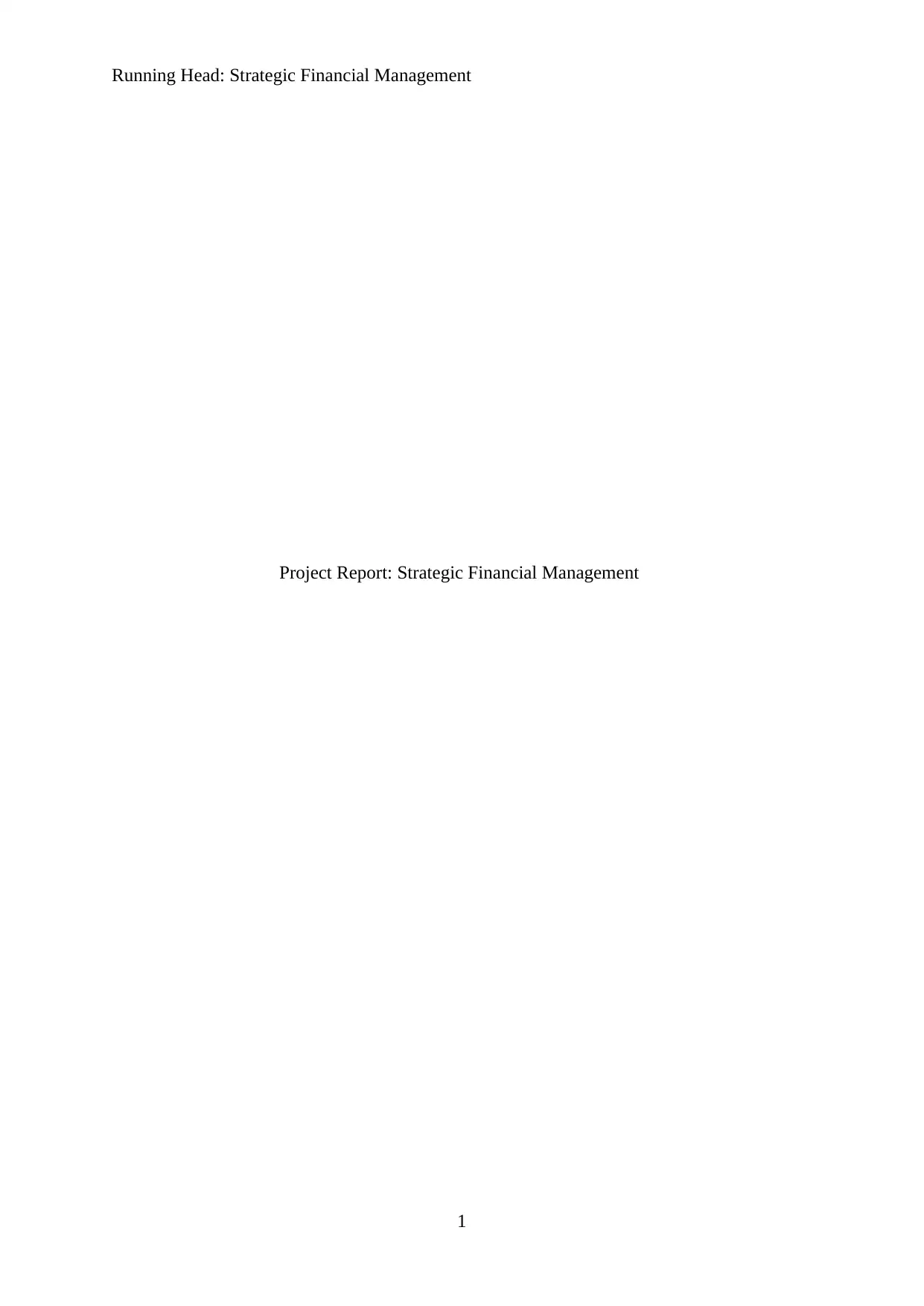
Running Head: Strategic Financial Management
Project Report: Strategic Financial Management
1
Project Report: Strategic Financial Management
1
Paraphrase This Document
Need a fresh take? Get an instant paraphrase of this document with our AI Paraphraser

Strategic Financial Management
Contents
Tools and techniques of cost accounting..........................................................................4
Concepts, features and importance of cost accounting.................................................4
Tools of costing design and system..............................................................................5
Recommendation..........................................................................................................6
Analysis of the financial performance..............................................................................8
Financial statement analysis.........................................................................................8
Financial statement evaluation...................................................................................11
Recommendation........................................................................................................15
Budgetary process of organization.................................................................................16
Evaluation of budgetary targets..................................................................................16
Development of master budget...................................................................................17
Evaluation of the budget and its process....................................................................18
Long term and short term sources..................................................................................21
Need for short term working capital and long term funds..........................................21
Appropriate source of short term funds......................................................................21
Choice of sources........................................................................................................22
Investment appraisal.......................................................................................................25
Financial appraisal methods.......................................................................................25
Strategic investment decision.....................................................................................27
Analysis over strategic investment decisions.............................................................30
References.......................................................................................................................32
Appendix.........................................................................................................................35
2
Contents
Tools and techniques of cost accounting..........................................................................4
Concepts, features and importance of cost accounting.................................................4
Tools of costing design and system..............................................................................5
Recommendation..........................................................................................................6
Analysis of the financial performance..............................................................................8
Financial statement analysis.........................................................................................8
Financial statement evaluation...................................................................................11
Recommendation........................................................................................................15
Budgetary process of organization.................................................................................16
Evaluation of budgetary targets..................................................................................16
Development of master budget...................................................................................17
Evaluation of the budget and its process....................................................................18
Long term and short term sources..................................................................................21
Need for short term working capital and long term funds..........................................21
Appropriate source of short term funds......................................................................21
Choice of sources........................................................................................................22
Investment appraisal.......................................................................................................25
Financial appraisal methods.......................................................................................25
Strategic investment decision.....................................................................................27
Analysis over strategic investment decisions.............................................................30
References.......................................................................................................................32
Appendix.........................................................................................................................35
2
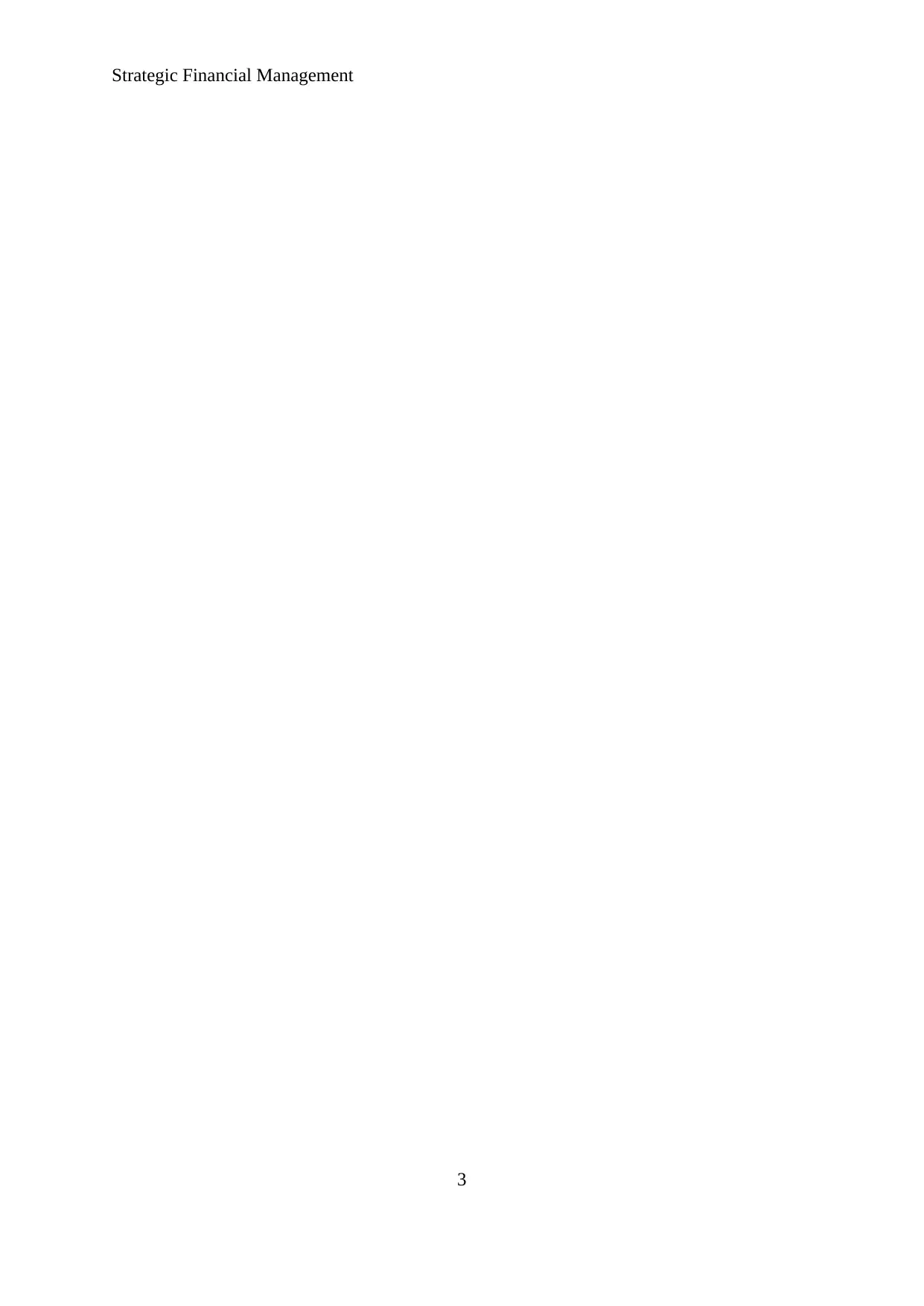
Strategic Financial Management
3
3
⊘ This is a preview!⊘
Do you want full access?
Subscribe today to unlock all pages.

Trusted by 1+ million students worldwide
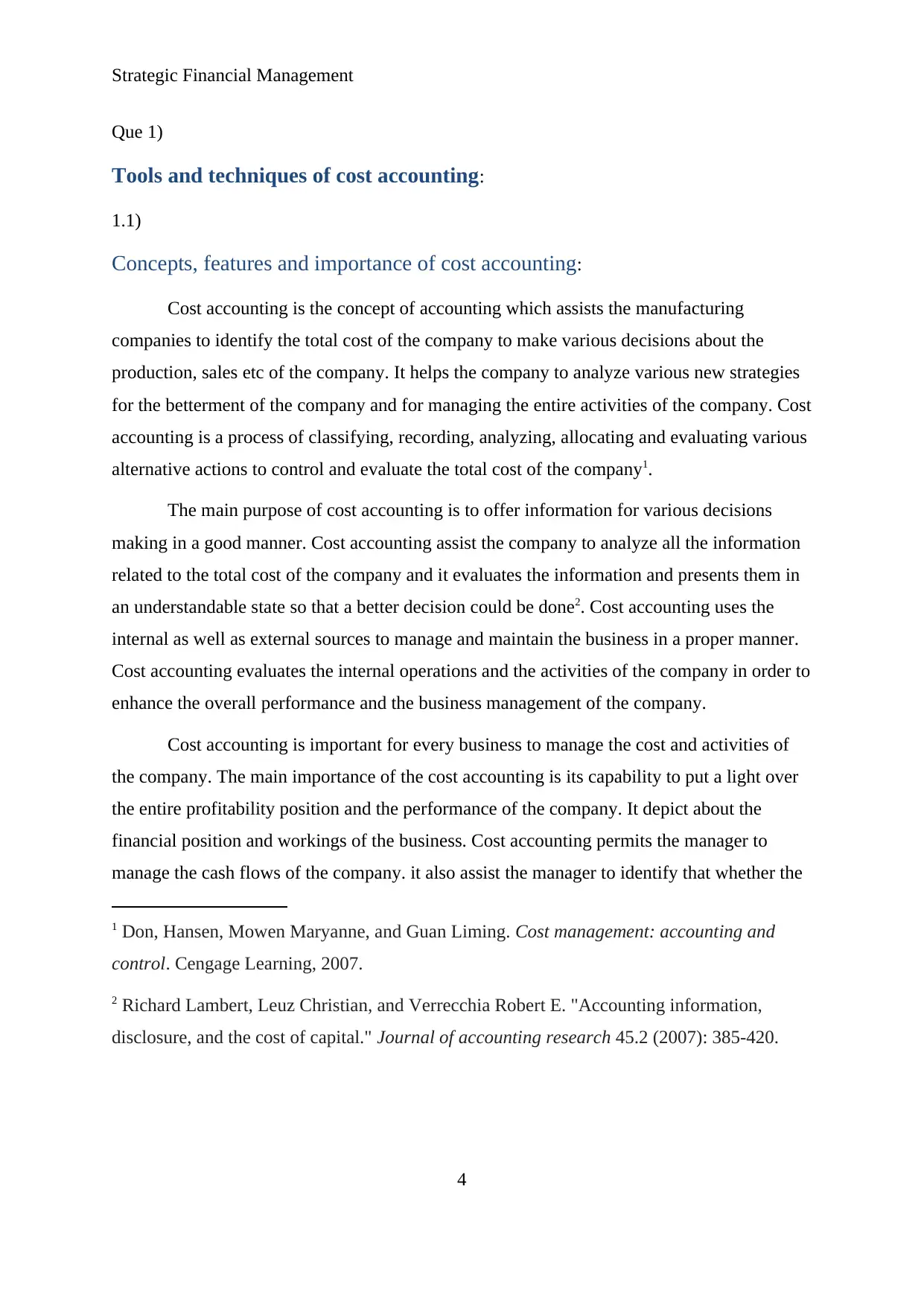
Strategic Financial Management
Que 1)
Tools and techniques of cost accounting:
1.1)
Concepts, features and importance of cost accounting:
Cost accounting is the concept of accounting which assists the manufacturing
companies to identify the total cost of the company to make various decisions about the
production, sales etc of the company. It helps the company to analyze various new strategies
for the betterment of the company and for managing the entire activities of the company. Cost
accounting is a process of classifying, recording, analyzing, allocating and evaluating various
alternative actions to control and evaluate the total cost of the company1.
The main purpose of cost accounting is to offer information for various decisions
making in a good manner. Cost accounting assist the company to analyze all the information
related to the total cost of the company and it evaluates the information and presents them in
an understandable state so that a better decision could be done2. Cost accounting uses the
internal as well as external sources to manage and maintain the business in a proper manner.
Cost accounting evaluates the internal operations and the activities of the company in order to
enhance the overall performance and the business management of the company.
Cost accounting is important for every business to manage the cost and activities of
the company. The main importance of the cost accounting is its capability to put a light over
the entire profitability position and the performance of the company. It depict about the
financial position and workings of the business. Cost accounting permits the manager to
manage the cash flows of the company. it also assist the manager to identify that whether the
1 Don, Hansen, Mowen Maryanne, and Guan Liming. Cost management: accounting and
control. Cengage Learning, 2007.
2 Richard Lambert, Leuz Christian, and Verrecchia Robert E. "Accounting information,
disclosure, and the cost of capital." Journal of accounting research 45.2 (2007): 385-420.
4
Que 1)
Tools and techniques of cost accounting:
1.1)
Concepts, features and importance of cost accounting:
Cost accounting is the concept of accounting which assists the manufacturing
companies to identify the total cost of the company to make various decisions about the
production, sales etc of the company. It helps the company to analyze various new strategies
for the betterment of the company and for managing the entire activities of the company. Cost
accounting is a process of classifying, recording, analyzing, allocating and evaluating various
alternative actions to control and evaluate the total cost of the company1.
The main purpose of cost accounting is to offer information for various decisions
making in a good manner. Cost accounting assist the company to analyze all the information
related to the total cost of the company and it evaluates the information and presents them in
an understandable state so that a better decision could be done2. Cost accounting uses the
internal as well as external sources to manage and maintain the business in a proper manner.
Cost accounting evaluates the internal operations and the activities of the company in order to
enhance the overall performance and the business management of the company.
Cost accounting is important for every business to manage the cost and activities of
the company. The main importance of the cost accounting is its capability to put a light over
the entire profitability position and the performance of the company. It depict about the
financial position and workings of the business. Cost accounting permits the manager to
manage the cash flows of the company. it also assist the manager to identify that whether the
1 Don, Hansen, Mowen Maryanne, and Guan Liming. Cost management: accounting and
control. Cengage Learning, 2007.
2 Richard Lambert, Leuz Christian, and Verrecchia Robert E. "Accounting information,
disclosure, and the cost of capital." Journal of accounting research 45.2 (2007): 385-420.
4
Paraphrase This Document
Need a fresh take? Get an instant paraphrase of this document with our AI Paraphraser
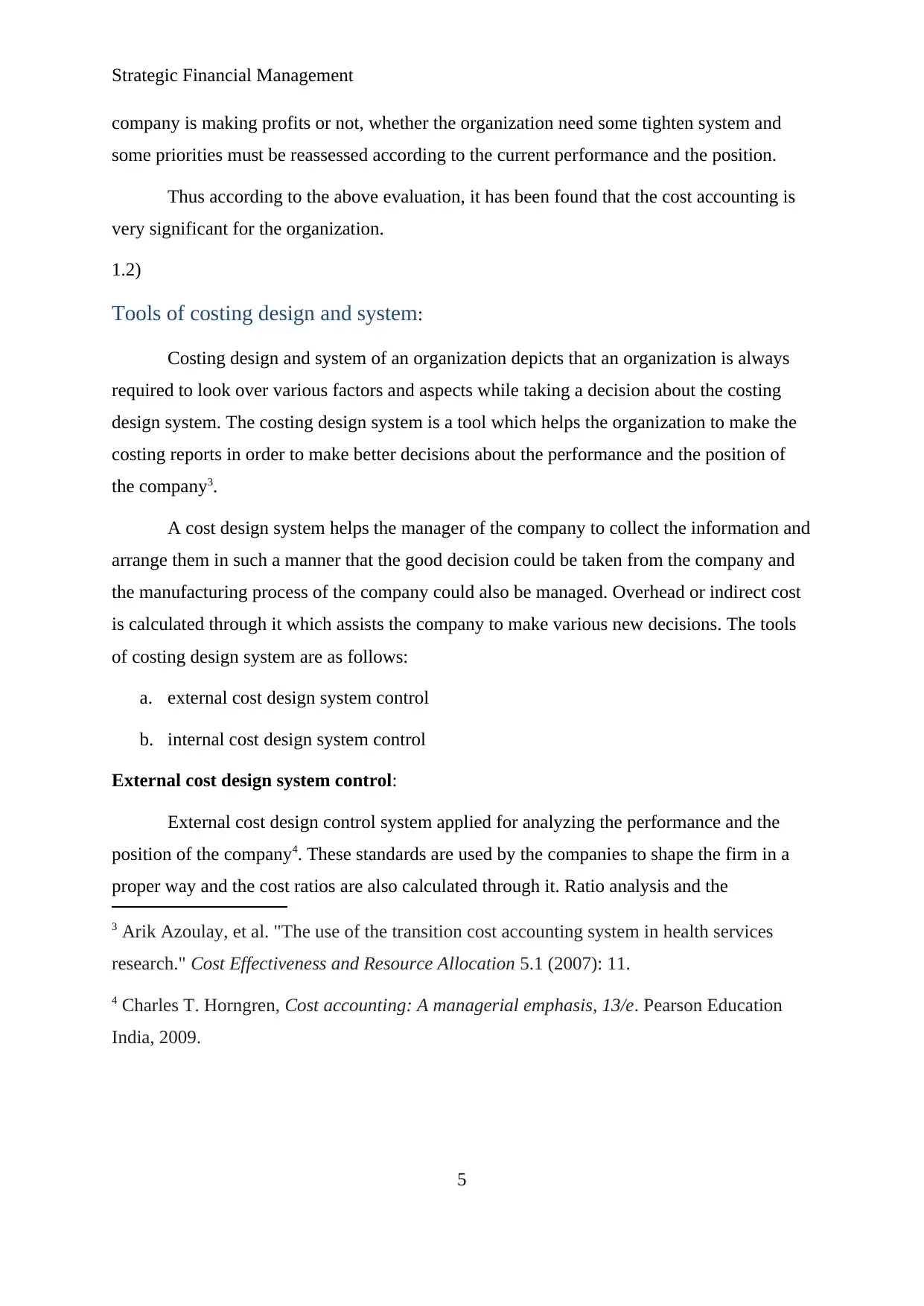
Strategic Financial Management
company is making profits or not, whether the organization need some tighten system and
some priorities must be reassessed according to the current performance and the position.
Thus according to the above evaluation, it has been found that the cost accounting is
very significant for the organization.
1.2)
Tools of costing design and system:
Costing design and system of an organization depicts that an organization is always
required to look over various factors and aspects while taking a decision about the costing
design system. The costing design system is a tool which helps the organization to make the
costing reports in order to make better decisions about the performance and the position of
the company3.
A cost design system helps the manager of the company to collect the information and
arrange them in such a manner that the good decision could be taken from the company and
the manufacturing process of the company could also be managed. Overhead or indirect cost
is calculated through it which assists the company to make various new decisions. The tools
of costing design system are as follows:
a. external cost design system control
b. internal cost design system control
External cost design system control:
External cost design control system applied for analyzing the performance and the
position of the company4. These standards are used by the companies to shape the firm in a
proper way and the cost ratios are also calculated through it. Ratio analysis and the
3 Arik Azoulay, et al. "The use of the transition cost accounting system in health services
research." Cost Effectiveness and Resource Allocation 5.1 (2007): 11.
4 Charles T. Horngren, Cost accounting: A managerial emphasis, 13/e. Pearson Education
India, 2009.
5
company is making profits or not, whether the organization need some tighten system and
some priorities must be reassessed according to the current performance and the position.
Thus according to the above evaluation, it has been found that the cost accounting is
very significant for the organization.
1.2)
Tools of costing design and system:
Costing design and system of an organization depicts that an organization is always
required to look over various factors and aspects while taking a decision about the costing
design system. The costing design system is a tool which helps the organization to make the
costing reports in order to make better decisions about the performance and the position of
the company3.
A cost design system helps the manager of the company to collect the information and
arrange them in such a manner that the good decision could be taken from the company and
the manufacturing process of the company could also be managed. Overhead or indirect cost
is calculated through it which assists the company to make various new decisions. The tools
of costing design system are as follows:
a. external cost design system control
b. internal cost design system control
External cost design system control:
External cost design control system applied for analyzing the performance and the
position of the company4. These standards are used by the companies to shape the firm in a
proper way and the cost ratios are also calculated through it. Ratio analysis and the
3 Arik Azoulay, et al. "The use of the transition cost accounting system in health services
research." Cost Effectiveness and Resource Allocation 5.1 (2007): 11.
4 Charles T. Horngren, Cost accounting: A managerial emphasis, 13/e. Pearson Education
India, 2009.
5
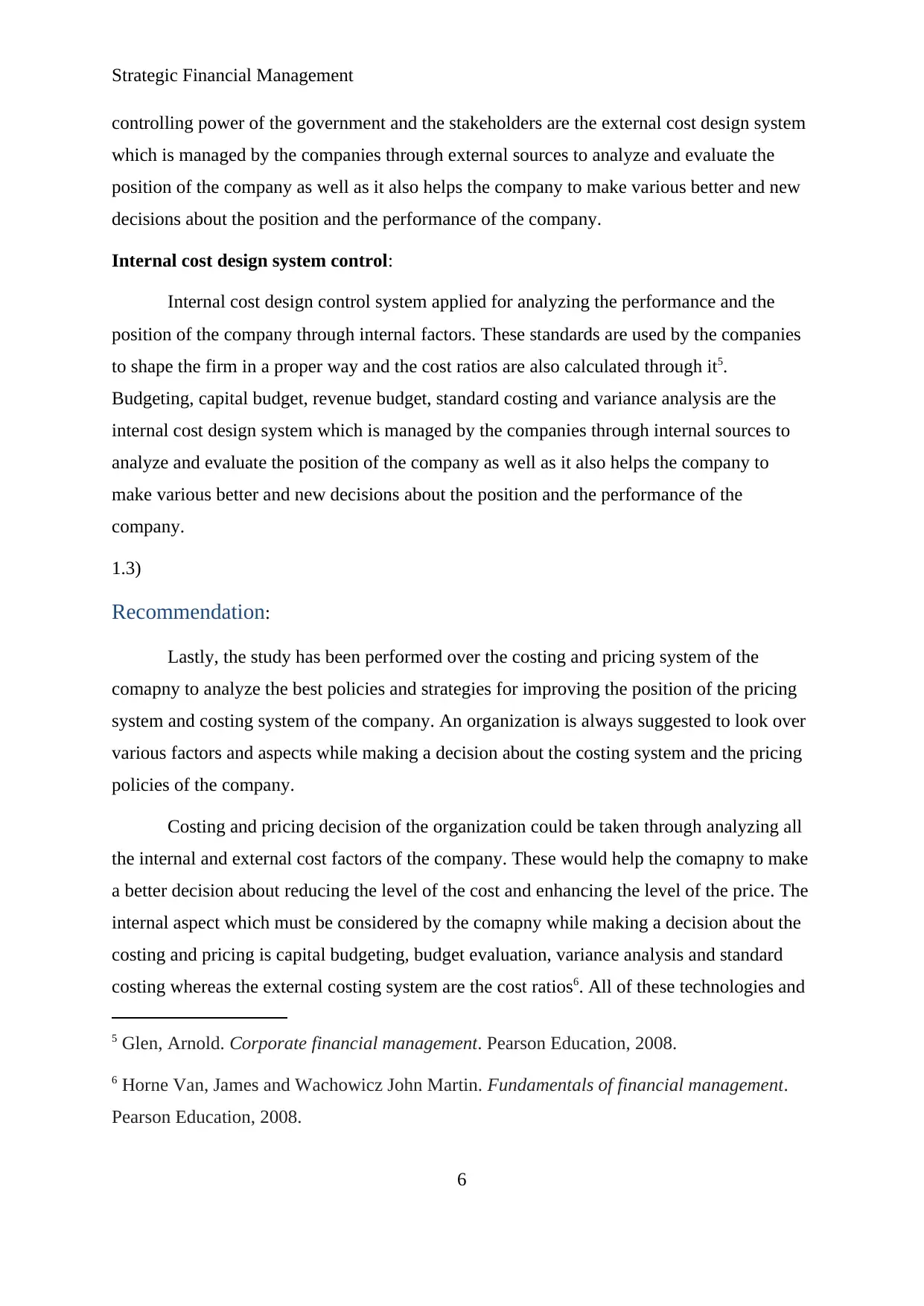
Strategic Financial Management
controlling power of the government and the stakeholders are the external cost design system
which is managed by the companies through external sources to analyze and evaluate the
position of the company as well as it also helps the company to make various better and new
decisions about the position and the performance of the company.
Internal cost design system control:
Internal cost design control system applied for analyzing the performance and the
position of the company through internal factors. These standards are used by the companies
to shape the firm in a proper way and the cost ratios are also calculated through it5.
Budgeting, capital budget, revenue budget, standard costing and variance analysis are the
internal cost design system which is managed by the companies through internal sources to
analyze and evaluate the position of the company as well as it also helps the company to
make various better and new decisions about the position and the performance of the
company.
1.3)
Recommendation:
Lastly, the study has been performed over the costing and pricing system of the
comapny to analyze the best policies and strategies for improving the position of the pricing
system and costing system of the company. An organization is always suggested to look over
various factors and aspects while making a decision about the costing system and the pricing
policies of the company.
Costing and pricing decision of the organization could be taken through analyzing all
the internal and external cost factors of the company. These would help the comapny to make
a better decision about reducing the level of the cost and enhancing the level of the price. The
internal aspect which must be considered by the comapny while making a decision about the
costing and pricing is capital budgeting, budget evaluation, variance analysis and standard
costing whereas the external costing system are the cost ratios6. All of these technologies and
5 Glen, Arnold. Corporate financial management. Pearson Education, 2008.
6 Horne Van, James and Wachowicz John Martin. Fundamentals of financial management.
Pearson Education, 2008.
6
controlling power of the government and the stakeholders are the external cost design system
which is managed by the companies through external sources to analyze and evaluate the
position of the company as well as it also helps the company to make various better and new
decisions about the position and the performance of the company.
Internal cost design system control:
Internal cost design control system applied for analyzing the performance and the
position of the company through internal factors. These standards are used by the companies
to shape the firm in a proper way and the cost ratios are also calculated through it5.
Budgeting, capital budget, revenue budget, standard costing and variance analysis are the
internal cost design system which is managed by the companies through internal sources to
analyze and evaluate the position of the company as well as it also helps the company to
make various better and new decisions about the position and the performance of the
company.
1.3)
Recommendation:
Lastly, the study has been performed over the costing and pricing system of the
comapny to analyze the best policies and strategies for improving the position of the pricing
system and costing system of the company. An organization is always suggested to look over
various factors and aspects while making a decision about the costing system and the pricing
policies of the company.
Costing and pricing decision of the organization could be taken through analyzing all
the internal and external cost factors of the company. These would help the comapny to make
a better decision about reducing the level of the cost and enhancing the level of the price. The
internal aspect which must be considered by the comapny while making a decision about the
costing and pricing is capital budgeting, budget evaluation, variance analysis and standard
costing whereas the external costing system are the cost ratios6. All of these technologies and
5 Glen, Arnold. Corporate financial management. Pearson Education, 2008.
6 Horne Van, James and Wachowicz John Martin. Fundamentals of financial management.
Pearson Education, 2008.
6
⊘ This is a preview!⊘
Do you want full access?
Subscribe today to unlock all pages.

Trusted by 1+ million students worldwide
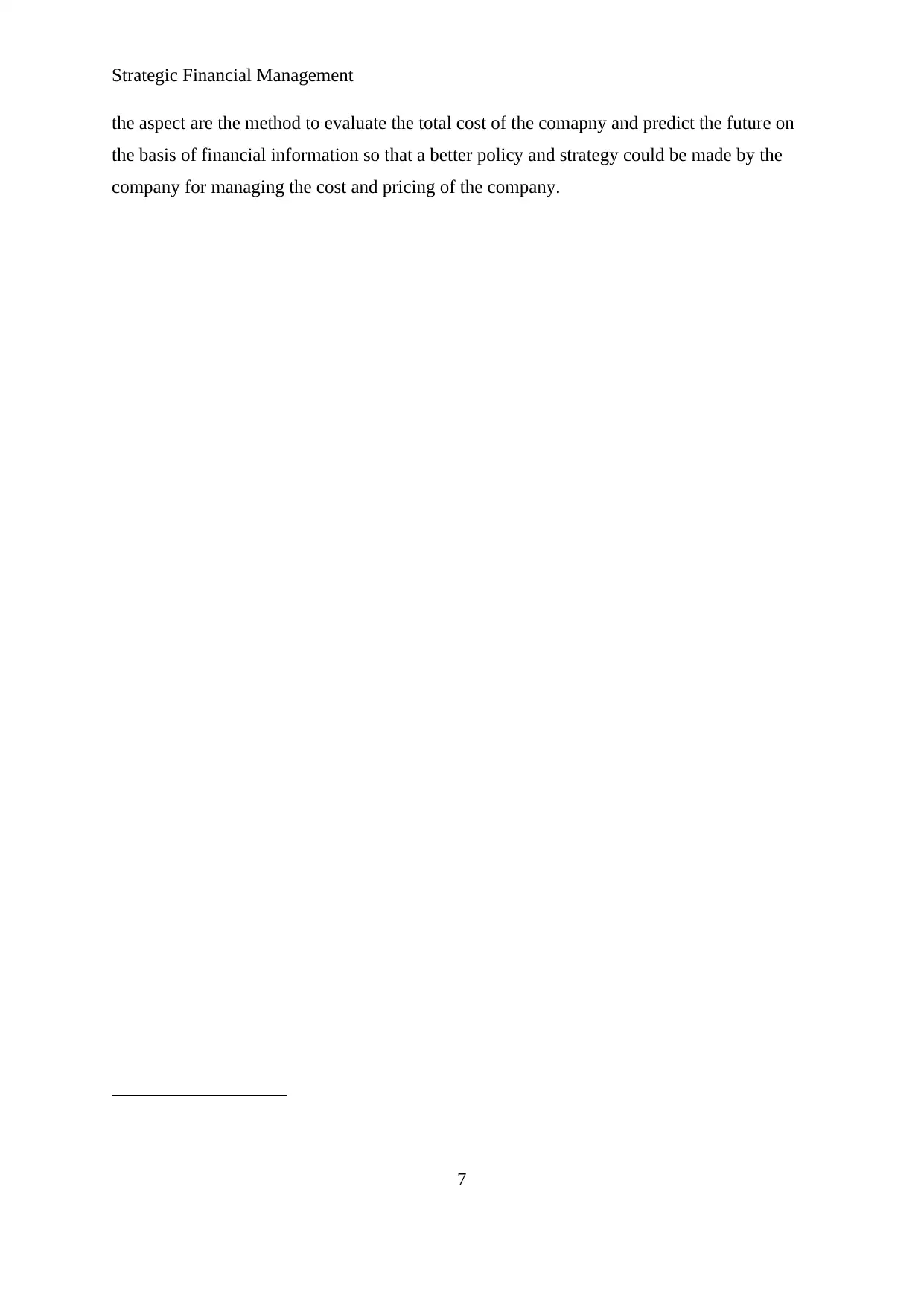
Strategic Financial Management
the aspect are the method to evaluate the total cost of the comapny and predict the future on
the basis of financial information so that a better policy and strategy could be made by the
company for managing the cost and pricing of the company.
7
the aspect are the method to evaluate the total cost of the comapny and predict the future on
the basis of financial information so that a better policy and strategy could be made by the
company for managing the cost and pricing of the company.
7
Paraphrase This Document
Need a fresh take? Get an instant paraphrase of this document with our AI Paraphraser
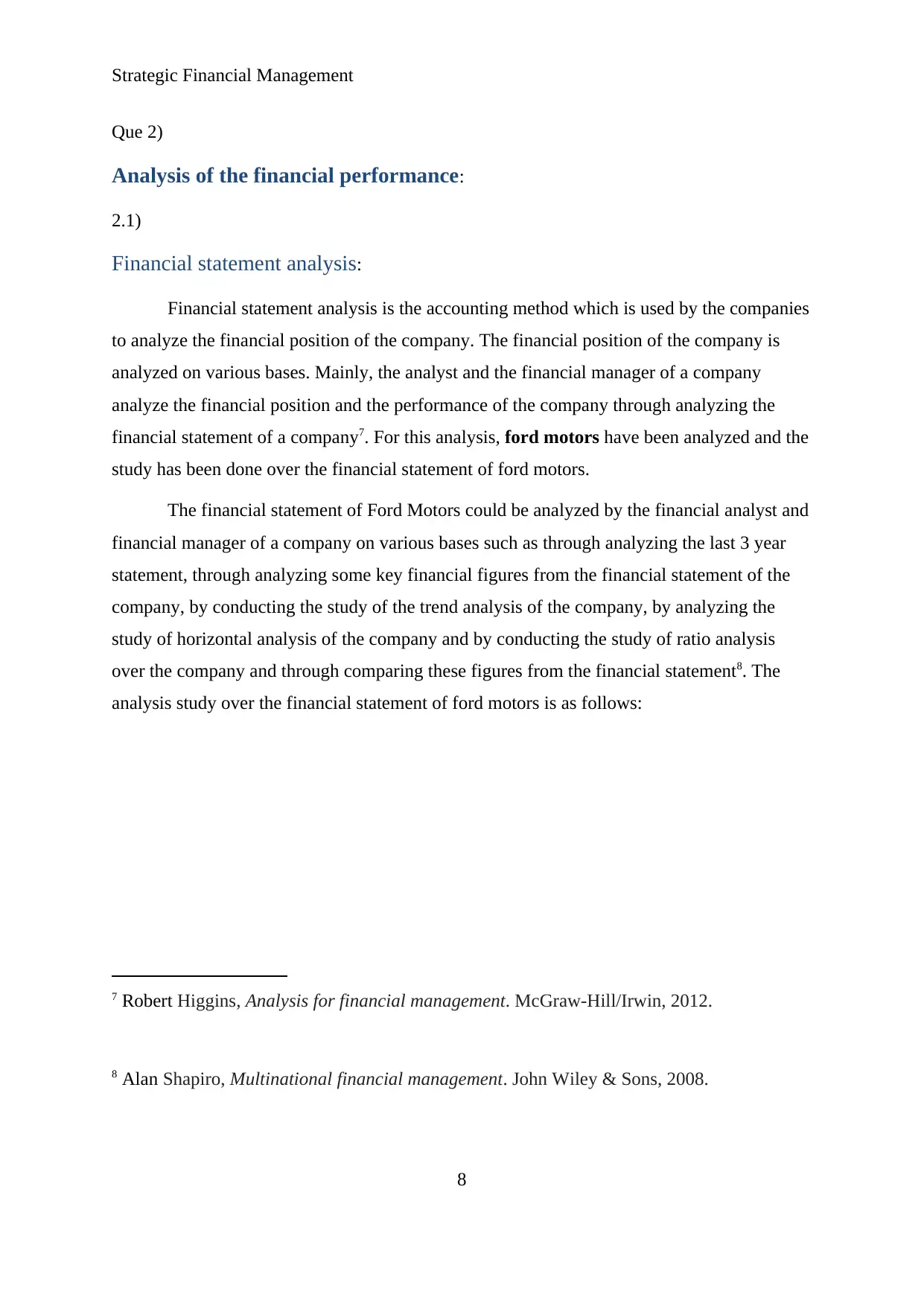
Strategic Financial Management
Que 2)
Analysis of the financial performance:
2.1)
Financial statement analysis:
Financial statement analysis is the accounting method which is used by the companies
to analyze the financial position of the company. The financial position of the company is
analyzed on various bases. Mainly, the analyst and the financial manager of a company
analyze the financial position and the performance of the company through analyzing the
financial statement of a company7. For this analysis, ford motors have been analyzed and the
study has been done over the financial statement of ford motors.
The financial statement of Ford Motors could be analyzed by the financial analyst and
financial manager of a company on various bases such as through analyzing the last 3 year
statement, through analyzing some key financial figures from the financial statement of the
company, by conducting the study of the trend analysis of the company, by analyzing the
study of horizontal analysis of the company and by conducting the study of ratio analysis
over the company and through comparing these figures from the financial statement8. The
analysis study over the financial statement of ford motors is as follows:
7 Robert Higgins, Analysis for financial management. McGraw-Hill/Irwin, 2012.
8 Alan Shapiro, Multinational financial management. John Wiley & Sons, 2008.
8
Que 2)
Analysis of the financial performance:
2.1)
Financial statement analysis:
Financial statement analysis is the accounting method which is used by the companies
to analyze the financial position of the company. The financial position of the company is
analyzed on various bases. Mainly, the analyst and the financial manager of a company
analyze the financial position and the performance of the company through analyzing the
financial statement of a company7. For this analysis, ford motors have been analyzed and the
study has been done over the financial statement of ford motors.
The financial statement of Ford Motors could be analyzed by the financial analyst and
financial manager of a company on various bases such as through analyzing the last 3 year
statement, through analyzing some key financial figures from the financial statement of the
company, by conducting the study of the trend analysis of the company, by analyzing the
study of horizontal analysis of the company and by conducting the study of ratio analysis
over the company and through comparing these figures from the financial statement8. The
analysis study over the financial statement of ford motors is as follows:
7 Robert Higgins, Analysis for financial management. McGraw-Hill/Irwin, 2012.
8 Alan Shapiro, Multinational financial management. John Wiley & Sons, 2008.
8

Strategic Financial Management
As
Reported
AnnualReport Date12/31/201
6
12/31/201
5
12/31/201
4
Scale Millions Millions Millions
Total Sales revenues149558 3.80% 144077 -1.93% 146917
Automotive cost of sales124041 0.43% 123516 -1.37% 125234
Gross Profit 25517 24.10% 20561 -5.17% 21683
Operating Expense
Selling, administrative & other expenses14999 6.25% 14117 7.14% 13176
Operating Income10518 63.22% 6444 -24.25% 8507
Other income
Automotive interest income & other income net1188 1463.16% 76 -92.20% 974
Financial services other income, net372 6.90% 348 0.00% 348
Equity in net income of affiliated companies1818 42.59% 1275 19.27% 1069
Other Expense
Financial Services interest expense2454 -9.08% 2699 -5.63% 2860
Financial services provision for credit & insurance losses417 36.72% 305 46.63% 208
Automotive interest expense773 -3.01% 797 -3.86% 829
Income (loss) before income taxes10252 136.11% 4342 -37.98% 7001
Provision for (benefit from) income taxes2881 149.22% 1156 -886.39% -147
Net income 7371 131.36% 3186 -55.43% 7148
income (loss) attributable to noncontrolling interests2 100.00% 1 -85.71% 7
Net income (loss) attributable to Ford Motor Company7373 131.35% 3187 -55.46% 7155
9
As
Reported
AnnualReport Date12/31/201
6
12/31/201
5
12/31/201
4
Scale Millions Millions Millions
Total Sales revenues149558 3.80% 144077 -1.93% 146917
Automotive cost of sales124041 0.43% 123516 -1.37% 125234
Gross Profit 25517 24.10% 20561 -5.17% 21683
Operating Expense
Selling, administrative & other expenses14999 6.25% 14117 7.14% 13176
Operating Income10518 63.22% 6444 -24.25% 8507
Other income
Automotive interest income & other income net1188 1463.16% 76 -92.20% 974
Financial services other income, net372 6.90% 348 0.00% 348
Equity in net income of affiliated companies1818 42.59% 1275 19.27% 1069
Other Expense
Financial Services interest expense2454 -9.08% 2699 -5.63% 2860
Financial services provision for credit & insurance losses417 36.72% 305 46.63% 208
Automotive interest expense773 -3.01% 797 -3.86% 829
Income (loss) before income taxes10252 136.11% 4342 -37.98% 7001
Provision for (benefit from) income taxes2881 149.22% 1156 -886.39% -147
Net income 7371 131.36% 3186 -55.43% 7148
income (loss) attributable to noncontrolling interests2 100.00% 1 -85.71% 7
Net income (loss) attributable to Ford Motor Company7373 131.35% 3187 -55.46% 7155
9
⊘ This is a preview!⊘
Do you want full access?
Subscribe today to unlock all pages.

Trusted by 1+ million students worldwide
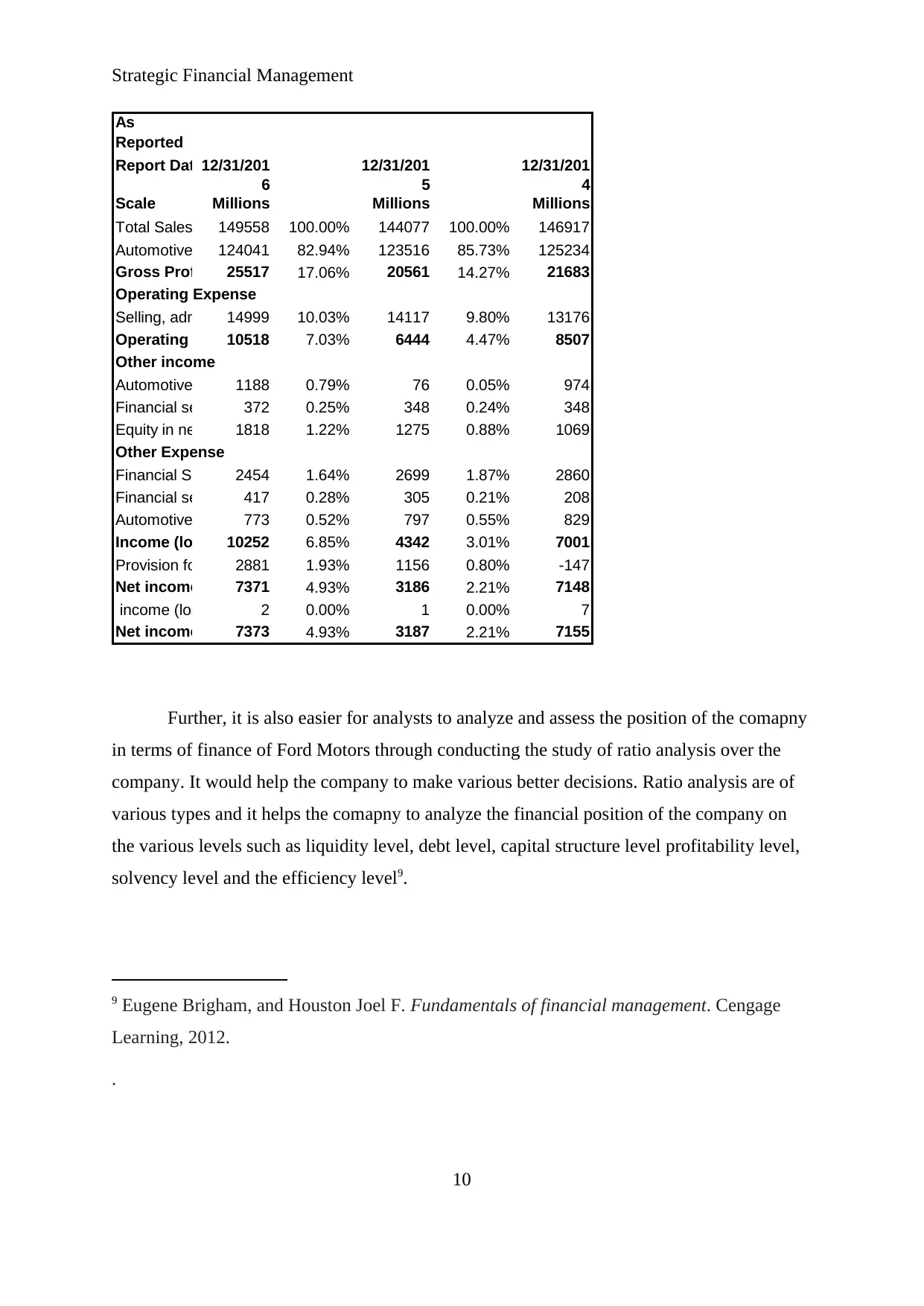
Strategic Financial Management
As
Reported
AnnualReport Date12/31/201
6
12/31/201
5
12/31/201
4
Scale Millions Millions Millions
Total Sales revenues149558 100.00% 144077 100.00% 146917
Automotive cost of sales124041 82.94% 123516 85.73% 125234
Gross Profit 25517 17.06% 20561 14.27% 21683
Operating Expense
Selling, administrative & other expenses14999 10.03% 14117 9.80% 13176
Operating Income10518 7.03% 6444 4.47% 8507
Other income
Automotive interest income & other income net1188 0.79% 76 0.05% 974
Financial services other income, net372 0.25% 348 0.24% 348
Equity in net income of affiliated companies1818 1.22% 1275 0.88% 1069
Other Expense
Financial Services interest expense2454 1.64% 2699 1.87% 2860
Financial services provision for credit & insurance losses417 0.28% 305 0.21% 208
Automotive interest expense773 0.52% 797 0.55% 829
Income (loss) before income taxes10252 6.85% 4342 3.01% 7001
Provision for (benefit from) income taxes2881 1.93% 1156 0.80% -147
Net income 7371 4.93% 3186 2.21% 7148
income (loss) attributable to noncontrolling interests2 0.00% 1 0.00% 7
Net income (loss) attributable to Ford Motor Company7373 4.93% 3187 2.21% 7155
Further, it is also easier for analysts to analyze and assess the position of the comapny
in terms of finance of Ford Motors through conducting the study of ratio analysis over the
company. It would help the company to make various better decisions. Ratio analysis are of
various types and it helps the comapny to analyze the financial position of the company on
the various levels such as liquidity level, debt level, capital structure level profitability level,
solvency level and the efficiency level9.
9 Eugene Brigham, and Houston Joel F. Fundamentals of financial management. Cengage
Learning, 2012.
.
10
As
Reported
AnnualReport Date12/31/201
6
12/31/201
5
12/31/201
4
Scale Millions Millions Millions
Total Sales revenues149558 100.00% 144077 100.00% 146917
Automotive cost of sales124041 82.94% 123516 85.73% 125234
Gross Profit 25517 17.06% 20561 14.27% 21683
Operating Expense
Selling, administrative & other expenses14999 10.03% 14117 9.80% 13176
Operating Income10518 7.03% 6444 4.47% 8507
Other income
Automotive interest income & other income net1188 0.79% 76 0.05% 974
Financial services other income, net372 0.25% 348 0.24% 348
Equity in net income of affiliated companies1818 1.22% 1275 0.88% 1069
Other Expense
Financial Services interest expense2454 1.64% 2699 1.87% 2860
Financial services provision for credit & insurance losses417 0.28% 305 0.21% 208
Automotive interest expense773 0.52% 797 0.55% 829
Income (loss) before income taxes10252 6.85% 4342 3.01% 7001
Provision for (benefit from) income taxes2881 1.93% 1156 0.80% -147
Net income 7371 4.93% 3186 2.21% 7148
income (loss) attributable to noncontrolling interests2 0.00% 1 0.00% 7
Net income (loss) attributable to Ford Motor Company7373 4.93% 3187 2.21% 7155
Further, it is also easier for analysts to analyze and assess the position of the comapny
in terms of finance of Ford Motors through conducting the study of ratio analysis over the
company. It would help the company to make various better decisions. Ratio analysis are of
various types and it helps the comapny to analyze the financial position of the company on
the various levels such as liquidity level, debt level, capital structure level profitability level,
solvency level and the efficiency level9.
9 Eugene Brigham, and Houston Joel F. Fundamentals of financial management. Cengage
Learning, 2012.
.
10
Paraphrase This Document
Need a fresh take? Get an instant paraphrase of this document with our AI Paraphraser
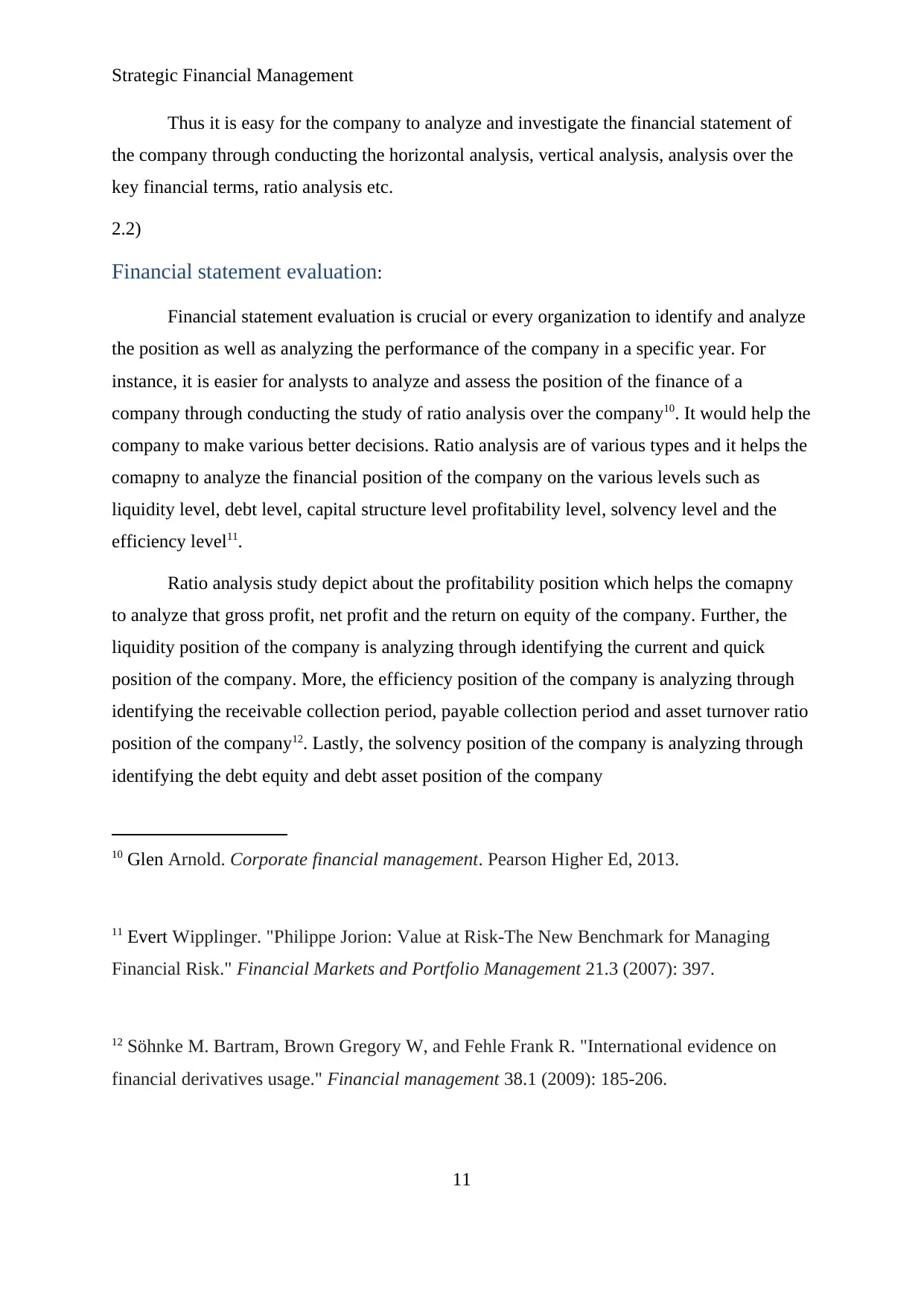
Strategic Financial Management
Thus it is easy for the company to analyze and investigate the financial statement of
the company through conducting the horizontal analysis, vertical analysis, analysis over the
key financial terms, ratio analysis etc.
2.2)
Financial statement evaluation:
Financial statement evaluation is crucial or every organization to identify and analyze
the position as well as analyzing the performance of the company in a specific year. For
instance, it is easier for analysts to analyze and assess the position of the finance of a
company through conducting the study of ratio analysis over the company10. It would help the
company to make various better decisions. Ratio analysis are of various types and it helps the
comapny to analyze the financial position of the company on the various levels such as
liquidity level, debt level, capital structure level profitability level, solvency level and the
efficiency level11.
Ratio analysis study depict about the profitability position which helps the comapny
to analyze that gross profit, net profit and the return on equity of the company. Further, the
liquidity position of the company is analyzing through identifying the current and quick
position of the company. More, the efficiency position of the company is analyzing through
identifying the receivable collection period, payable collection period and asset turnover ratio
position of the company12. Lastly, the solvency position of the company is analyzing through
identifying the debt equity and debt asset position of the company
10 Glen Arnold. Corporate financial management. Pearson Higher Ed, 2013.
11 Evert Wipplinger. "Philippe Jorion: Value at Risk-The New Benchmark for Managing
Financial Risk." Financial Markets and Portfolio Management 21.3 (2007): 397.
12 Söhnke M. Bartram, Brown Gregory W, and Fehle Frank R. "International evidence on
financial derivatives usage." Financial management 38.1 (2009): 185-206.
11
Thus it is easy for the company to analyze and investigate the financial statement of
the company through conducting the horizontal analysis, vertical analysis, analysis over the
key financial terms, ratio analysis etc.
2.2)
Financial statement evaluation:
Financial statement evaluation is crucial or every organization to identify and analyze
the position as well as analyzing the performance of the company in a specific year. For
instance, it is easier for analysts to analyze and assess the position of the finance of a
company through conducting the study of ratio analysis over the company10. It would help the
company to make various better decisions. Ratio analysis are of various types and it helps the
comapny to analyze the financial position of the company on the various levels such as
liquidity level, debt level, capital structure level profitability level, solvency level and the
efficiency level11.
Ratio analysis study depict about the profitability position which helps the comapny
to analyze that gross profit, net profit and the return on equity of the company. Further, the
liquidity position of the company is analyzing through identifying the current and quick
position of the company. More, the efficiency position of the company is analyzing through
identifying the receivable collection period, payable collection period and asset turnover ratio
position of the company12. Lastly, the solvency position of the company is analyzing through
identifying the debt equity and debt asset position of the company
10 Glen Arnold. Corporate financial management. Pearson Higher Ed, 2013.
11 Evert Wipplinger. "Philippe Jorion: Value at Risk-The New Benchmark for Managing
Financial Risk." Financial Markets and Portfolio Management 21.3 (2007): 397.
12 Söhnke M. Bartram, Brown Gregory W, and Fehle Frank R. "International evidence on
financial derivatives usage." Financial management 38.1 (2009): 185-206.
11
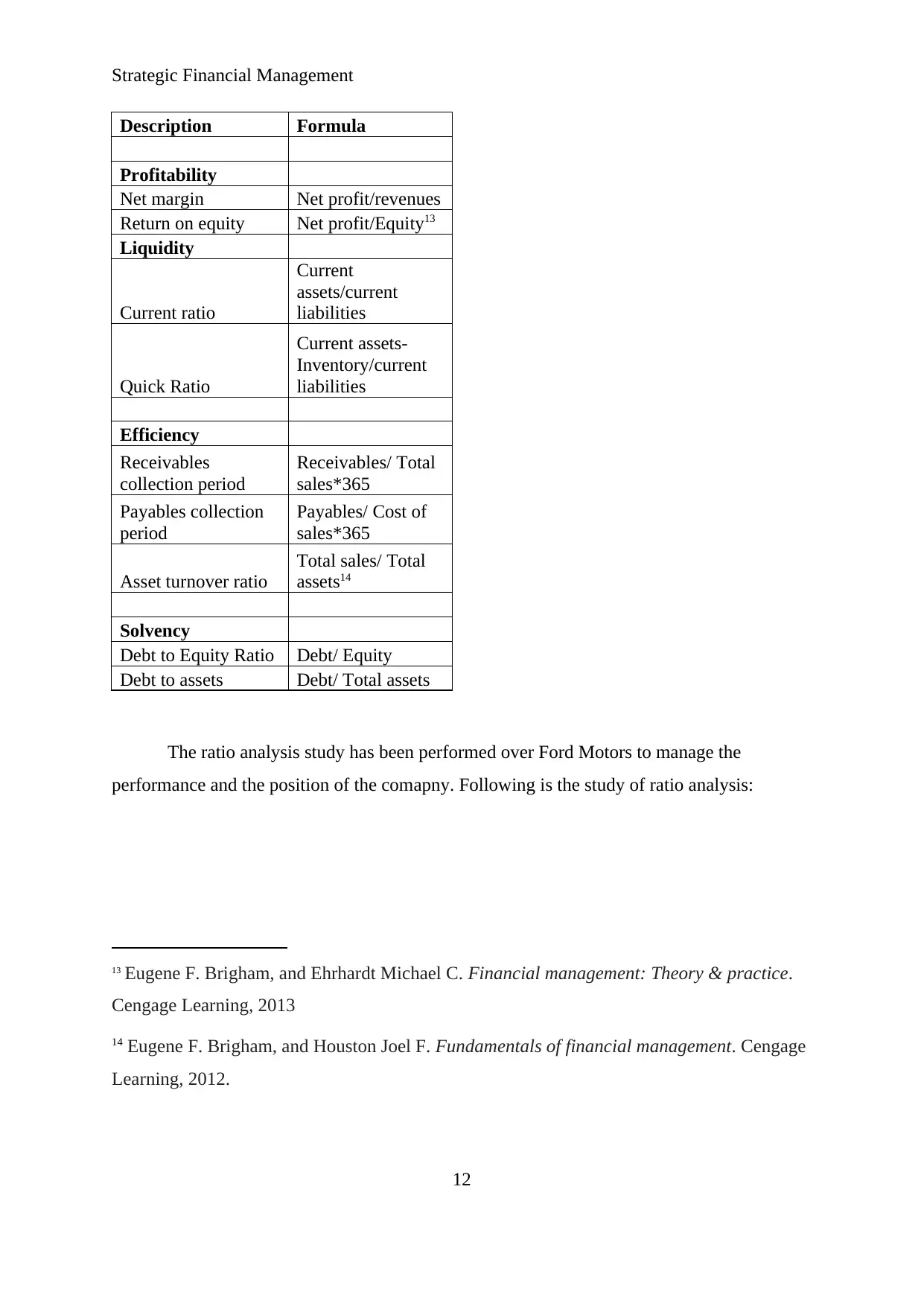
Strategic Financial Management
Description Formula
Profitability
Net margin Net profit/revenues
Return on equity Net profit/Equity13
Liquidity
Current ratio
Current
assets/current
liabilities
Quick Ratio
Current assets-
Inventory/current
liabilities
Efficiency
Receivables
collection period
Receivables/ Total
sales*365
Payables collection
period
Payables/ Cost of
sales*365
Asset turnover ratio
Total sales/ Total
assets14
Solvency
Debt to Equity Ratio Debt/ Equity
Debt to assets Debt/ Total assets
The ratio analysis study has been performed over Ford Motors to manage the
performance and the position of the comapny. Following is the study of ratio analysis:
13 Eugene F. Brigham, and Ehrhardt Michael C. Financial management: Theory & practice.
Cengage Learning, 2013
14 Eugene F. Brigham, and Houston Joel F. Fundamentals of financial management. Cengage
Learning, 2012.
12
Description Formula
Profitability
Net margin Net profit/revenues
Return on equity Net profit/Equity13
Liquidity
Current ratio
Current
assets/current
liabilities
Quick Ratio
Current assets-
Inventory/current
liabilities
Efficiency
Receivables
collection period
Receivables/ Total
sales*365
Payables collection
period
Payables/ Cost of
sales*365
Asset turnover ratio
Total sales/ Total
assets14
Solvency
Debt to Equity Ratio Debt/ Equity
Debt to assets Debt/ Total assets
The ratio analysis study has been performed over Ford Motors to manage the
performance and the position of the comapny. Following is the study of ratio analysis:
13 Eugene F. Brigham, and Ehrhardt Michael C. Financial management: Theory & practice.
Cengage Learning, 2013
14 Eugene F. Brigham, and Houston Joel F. Fundamentals of financial management. Cengage
Learning, 2012.
12
⊘ This is a preview!⊘
Do you want full access?
Subscribe today to unlock all pages.

Trusted by 1+ million students worldwide
1 out of 51
Related Documents
Your All-in-One AI-Powered Toolkit for Academic Success.
+13062052269
info@desklib.com
Available 24*7 on WhatsApp / Email
![[object Object]](/_next/static/media/star-bottom.7253800d.svg)
Unlock your academic potential
Copyright © 2020–2025 A2Z Services. All Rights Reserved. Developed and managed by ZUCOL.





